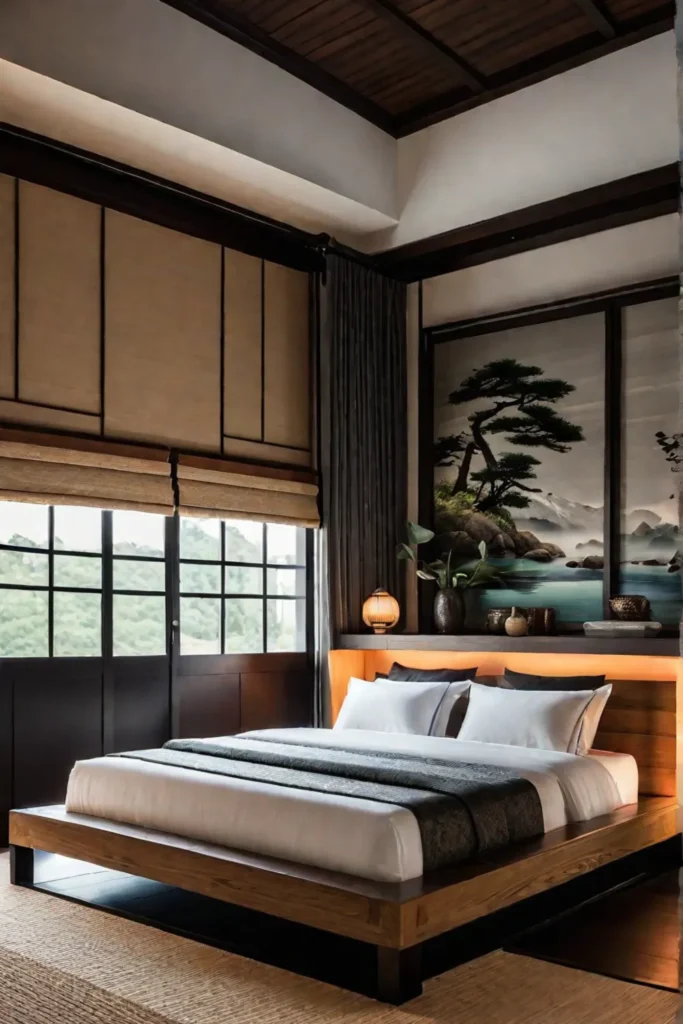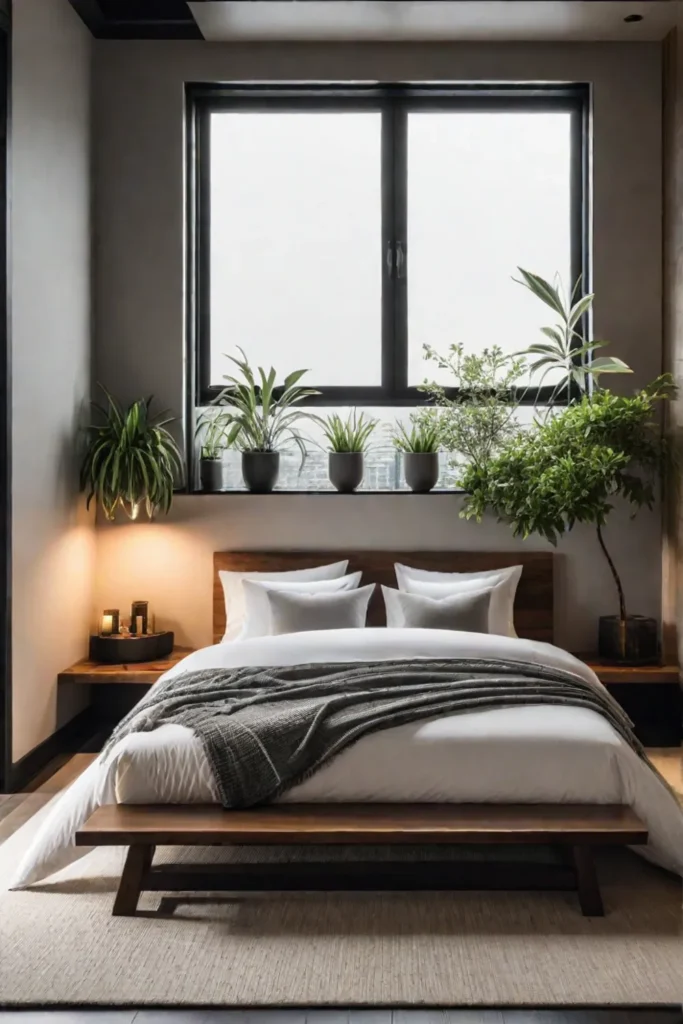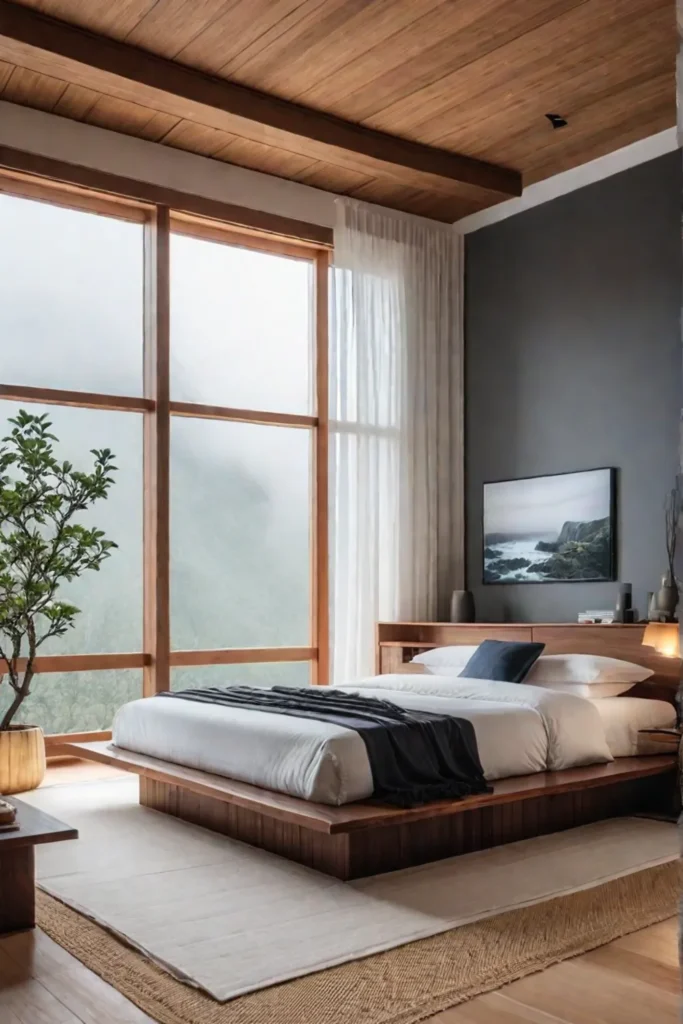Do you ever feel like your bedroom is more chaotic than calming? In our fast-paced world, having a sanctuary where we can truly unwind and recharge is more important than ever. That’s where the beauty of Japanese-inspired bedrooms comes into play.
Imagine stepping into a space that embodies the essence of tranquility and minimalism. A room where clutter is nowhere to be found, and natural elements like wood and plants create a serene atmosphere. This isn’t just a dream – it’s a reality you can bring to life in your home.
This article will explore nine key ideas to infuse your bedroom with a Japanese aesthetic. By incorporating these principles, you can transform your sleeping space into a peaceful oasis where relaxation and rejuvenation take center stage. Get ready to say goodbye to stress and hello to a Zen-like slumber.
Embrace Minimalism
At the heart of Japanese design lies the principle of “less is more.” This minimalist approach is not just about aesthetics; it can also profoundly impact your mental well-being. Studies show that living in a cluttered environment can lead to increased stress and anxiety levels. By embracing minimalism in your bedroom, you can create a calming space that promotes peace of mind.

Start by critically looking at your belongings and asking yourself, “Do I need this?” Donate, recycle, or sell items that don’t serve a purpose or bring you joy. Remember, the goal is to keep only the essentials, allowing your breathing space and mind to find respite.
Incorporate Natural Materials
Japanese design deeply appreciates the beauty of nature, and this is reflected in the materials used throughout the home. Incorporate natural elements like wood, bamboo, and paper in your bedroom to create a harmonious and grounding atmosphere.
Wooden furniture, such as a minimalist bed frame or a sleek dresser, can instantly warm up the space. Bamboo accents add an organic touch, like a bamboo lamp or a woven basket. And remember the power of paper – shoji screens or rice paper lanterns can soften the lighting and add a touch of elegance.

By surrounding yourself with these natural materials, you’ll feel a stronger connection to the outdoors, even in the comfort of your bedroom.
Choose a Neutral Color Palette
The color palette plays a crucial role when creating a tranquil and Zen-like bedroom. Soft, earthy tones like blues, greens, grays, and beiges can calm the mind and body.
Color psychologists say these neutral hues are associated with serenity and relaxation. They allow you to layer in textures and patterns without overwhelming the space, creating a harmonious and visually soothing environment.

Consider painting your walls in a soft, muted tone, or opt for neutral-toned bedding and window treatments. The goal is to create a seamless, calming canvas that allows your eyes to rest and your mind to unwind.
Invest in a Futon or Low Bed
In traditional Japanese homes, sleeping close to the ground is a cultural tradition that reflects humility and a connection to the earth. This practice is embodied in using futons or low-profile beds, which can offer physical and psychological benefits.
Sleeping on a futon or low bed can help improve your posture and reduce back pain by promoting better spinal alignment. Additionally, these beds are often made from natural materials like cotton or wool, which can minimize exposure to synthetic fibers and chemicals found in many Western-style mattresses.

When selecting a futon or low bed, look for high-quality craftsmanship and natural materials that provide comfort and aesthetic appeal. With a little research, you can find the perfect low-profile sleeping solution to enhance your Japanese-inspired bedroom.
Incorporate Shoji Screens and Doors
Shoji screens are a hallmark of traditional Japanese architecture and can be a beautiful addition to your bedroom. These screens, made of a wooden frame covered with translucent paper, serve multiple purposes: they provide privacy, control the flow of light, and add a touch of elegance to any space.
The soft, diffused light that filters through shoji screens creates a warm and inviting atmosphere, perfect for a peaceful slumber. You can use them as sliding doors to divide the room or as standalone screens to develop a sense of separation and intimacy.

Modern adaptations of shoji screens, such as those made with frosted glass, offer even more versatility and privacy while maintaining the signature Japanese aesthetic.
Add a Touch of Nature with Plants
Bringing the outdoors in is a fundamental aspect of Japanese design, and incorporating plants into your bedroom is a simple way to achieve this. Plants add a refreshing, natural element to the space and can also help purify the air and promote a sense of calm.
Consider adding some of the following plant varieties to your bedroom:
- Bamboo Palm: Effective at removing toxins from the air and thrives in low-light conditions.
- Spider Plant: Easy to care for and helps filter out formaldehyde and other pollutants.
- Peace Lily: Elegant white blooms and the ability to remove harmful chemicals from the air.

Remember to research the specific care requirements for each plant to ensure they thrive in your bedroom environment. With the right plants, you can create a serene, nature-inspired oasis.
Integrate Tatami Mats
Tatami mats are a quintessential element of traditional Japanese interior design, and they can be a beautiful addition to your bedroom. These woven straw mats provide a natural and insulating flooring option and contribute to the overall aesthetic of a Zen-like space.
Historically, tatami mats were the foundation for sleeping arrangements in Japanese homes, complementing the low-profile futon or platform beds. The soft, cushioned surface of the mats creates a sense of comfort and connection to the earth, while their uniform size and simple design add to the minimalist appeal.

When incorporating tatami mats into your bedroom, be mindful of their care and maintenance. Regularly sweep or vacuum the surfaces to keep them clean, and avoid placing heavy furniture directly on top to prevent damage.
Use Soft Lighting
Lighting plays a crucial role in creating a Zen-like ambiance in your bedroom. Soft, diffused lighting can help set the tone for relaxation and tranquility, allowing your mind and body to unwind.
Look for lighting fixtures that mimic traditional Japanese interiors’ gentle, warm glow. Paper lanterns, bamboo shade lamps, and even DIY washi tape accents can all contribute to this calming effect.

When arranging your bedroom lighting, avoid harsh overhead fixtures and opt for wall sconces or bedside lamps at eye level. This will help reduce shadows and glare, creating a more soothing environment. Complement your soft lighting with the strategic use of natural daylight, using light-filtering curtains or shades to control the brightness.
Incorporate Zen Art and Elements
To complete your Japanese-inspired bedroom, consider incorporating Zen art and natural elements that evoke a sense of calm and serenity. Minimalist artwork, such as calligraphy or landscape paintings, can add depth and sophistication to the space without overwhelming it.
Additionally, the Japanese philosophy of Wabi-Sabi, which embraces imperfection and beauty in flaws, can be a guiding principle for your decor choices. Look for handmade pottery, loose linens, or exposed light bulbs that celebrate each item’s unique character.

By thoughtfully selecting these Zen-inspired elements, you’ll create a bedroom that looks beautiful and promotes a deep sense of tranquility and inner peace.
Conclusion
Incorporating these nine Japanese-inspired ideas into your bedroom allows you to transform your sleeping space into a true oasis of calm and relaxation. From embracing minimalism to integrating natural materials and Zen-like lighting, each element works together to create a harmonious and serene environment.
As you embark on your journey to a more tranquil bedroom, remember that the key is to focus on simplicity, functionality, and a deep connection to nature. Experiment with these ideas, be bold and personalize them to suit your unique style and preferences.
So, which of these Japanese-inspired bedroom ideas are you most excited to try? Please share your thoughts in the comments below, and let’s inspire each other to create our own Zen-like sanctuaries.










